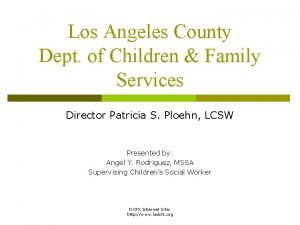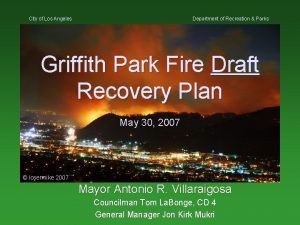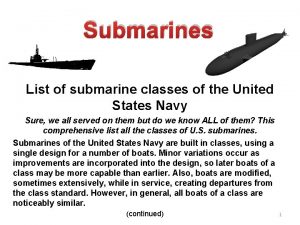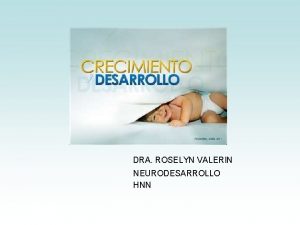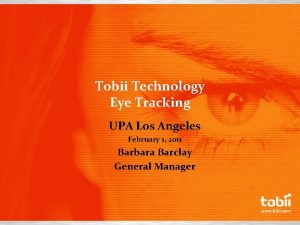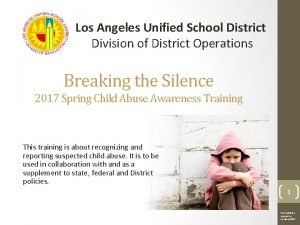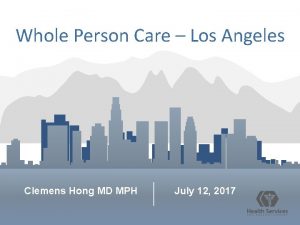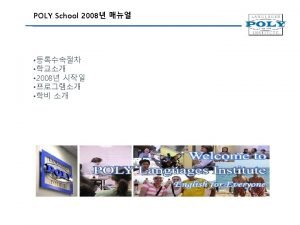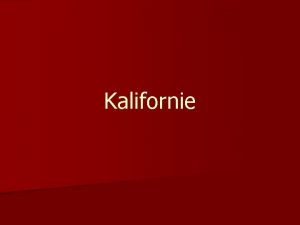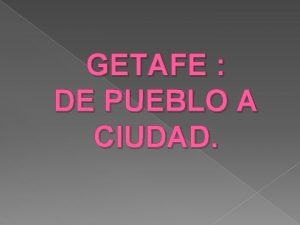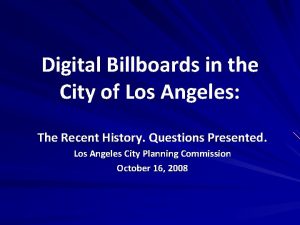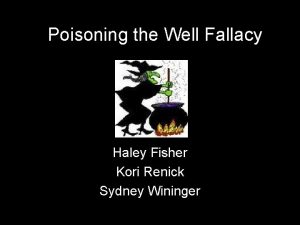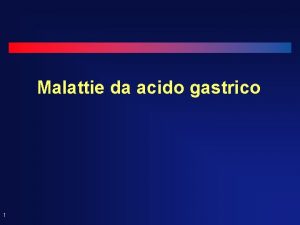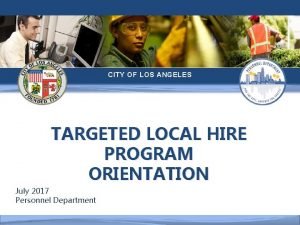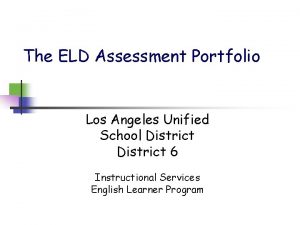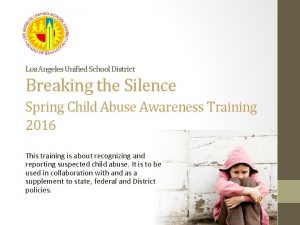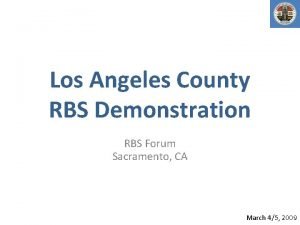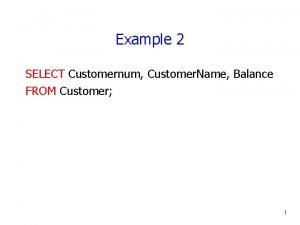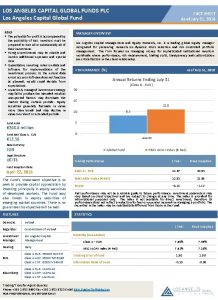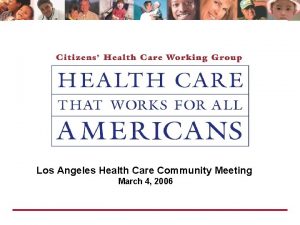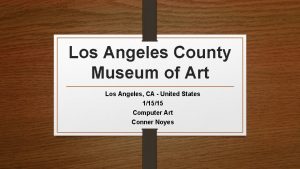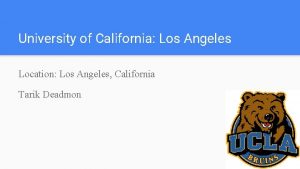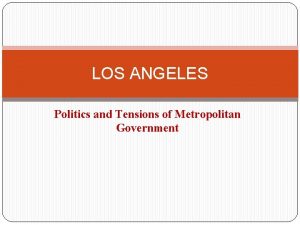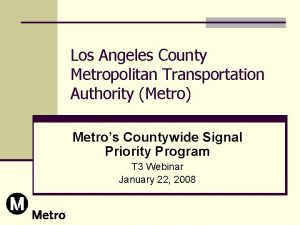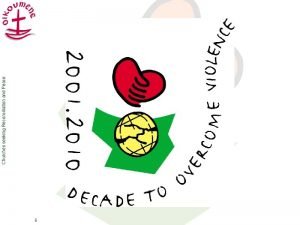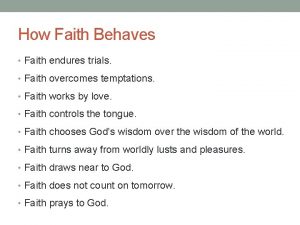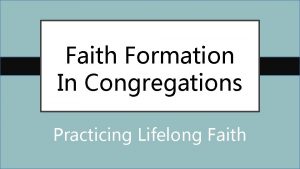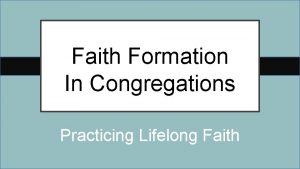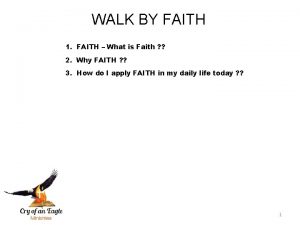Los Angeles Metropolitan Churches and PSATTC with Faith
















































- Slides: 48

Los Angeles Metropolitan Churches and PSATTC with Faith Based Training May 4, 2013

Topics of Discussion • Introduction of the TAP 21 • Introduction of the Scope of Professional Practice • Foundations for Addiction Professionals • 12 Core Competencies for Clergy

Training Objective Teach participants about core competencies that will enable clergy and other pastoral ministers to practice new science in addiction and alcohol treatment and to encourage faith communities in LAC to become users of SAMHSA TAPs and TIPs.

Purpose of Certification • Assure the public a minimum level of competency for quality service • Give community workers professional status and recognition to qualified addiction professionals through a process that examines demonstrated work competencies (Workforce Development for Target Population)

National Standards • TAP 21 - Addiction Counseling Competencies: The Knowledge, Skills and Attitudes of Professional Practice • In an effort to standardize the process of certification in the State of California, while elevating the level of professionalism within the field, AAAOD and LAM uses national standards for substance abuse counseling.

Knowledge, Skills, Attitudes • Transdisciplinary Foundations – identify the knowledge and attitudes that underlie competent practice—(i. e. cultural competence and peer-based) • Skills may vary across disciplines but the knowledge and attitudes provide a basis of understanding that should be common to all addiction professionals

Transdisciplinary Foundations (A) Understanding Addiction (C) Application to Practice (B) Treatment Knowledge (D) Professional Readiness

8 Practice Dimensions Clinical evaluation (assessment/interview) Treatment planning Referral Service coordination Counseling Client, family and community education Documentation Professional and ethical responsibilities

Dimensions of Professional Practice IV. Professional Readiness III. Application to Practice II. Treatment Knowledge I. Understanding Addiction Transdisciplinary Foundations VIII Professional & Ethical Responsibilities VI Documentation V Client, Family, & Community Education IV Counseling Treatment Planning III Service Coordination II Ref erra l l erra I Clinical Evaluation Addiction Counseling Competencies: The Knowledge, Skills and Attitudes of Professional Practice

Comparison of the Eight Practice Dimensions of Addiction Counseling Competencies (KSA’s) With the 12 Core Functions Knowledge, Skills, Attitudes 12 Core Functions Clinical Evaluation (Screening & Assessment) Screening Intake Orientation Assessment Treatment Planning Counseling (Individual, Group, Counseling Families, Couples & Significant Others) Counseling Crisis Intervention Service Coordination (Implement Treatment Plan Consulting, Continuing Assessment & Treatment Planning) Case Management Client, Family and Community Education Client Education Referral Documentation Reports and Record Keeping Professional and Ethical Responsibilities Consultation with Other Professionals

Similarities/differences? KSA’s 12 Core Functions Service coordination The administrative, clinical, and evaluative activities that bring the client, treatment services, community agencies, and other resources together to focus on issues and needs identified in the treatment plan. Case Management Activities intended to bring services, agencies, resources, or people together within a planned framework of action toward the achievement of established goals. It may involve liaison activities and collateral contacts.

12 Core Competencies for Clergy & Other Pastoral Ministers 1. Be Aware of the: – – Generally accepted definition of alcohol and drug dependence Societal Stigma attached to alcohol and drug dependence 2. Be knowledgeable about the: - Signs of alcohol and drug dependence Characteristics of withdrawal Effects on the individual and the family Characteristics of the stages of recovery 3. Be aware that possible indicators of the disease may include: among others: marital conflict, family violence, suicide, hospitalization or encounters with the criminal justice System

12 Core Competencies for Clergy & Other Pastoral Ministers 4. Understand that addiction erodes and blocks religious and spiritual development 5. Be aware of the potential benefits of early intervention to the: - addicted person - family system - affected children

12 Core Competencies for Clergy & Other Pastoral Ministers 7. Be able to communicate and sustain: - An appropriate level of concern - Messages of hope and caring 8. Be familiar with and utilize available community resources to ensure a continuum of care for the: - addicted person - family system - affected children

12 Core Competencies for Clergy & Other Pastoral Ministers 9. Have a general knowledge of and exposure to: - 12 -step programs (i. e. Free-N-One, AA, NA, CA, Alateen) - Other groups 10. Be able to acknowledge and address values, issues, and attitudes regarding alcohol and drug use and dependence in: - Oneself - One’s own family

12 Core Competencies for Clergy & Other Pastoral Ministers 11. Be able to shape, form and educate a caring congregation that welcomes and supports persons and families affected by alcohol and drug dependence 12. Be aware of how prevention strategies can benefit the larger community

Deep Dive Documentation Competency

What is Documentation? Basic Definition: The act or an instance of the supplying of written documents or supporting references or records. Most commonly used for developing treatment plan Goals & Objectives; • Goals are the hoped for—to be achieved in the best possible world. • Objectives are: measurable, specific, achievable – Objectives should contain: » 1) Client name/identifying info/number » 2) # persons to be served and/or participate » 3) time frame from start to finish » 4) expected measurable tasks to complete » 5) geographic location (optional) 18

Documentation Approach What is the Problem ? ü Must clearly define need for treatment plan/case management and document it daily, weekly, monthly, annually. üIncreasingly, the Addiction Counselor must also work with the inter-disciplinary team to establish the treatment plan (MHT; MD). ü This team is composed of the consumer, case manager, FQHC/medical provider, mental health therapist and/or other natural supports such as family and friends. üService coordination is top priority! 19 Is It Working? Response to Intervention/ Instruction Client & Family What Are We going to Do About It? Intervention/ Solution Why Is It Occurring?

Progress Note Documentation • There should be a progress note documented following each clinical session, for each day that the consumer is present in a residential or detox program, and at the time of discharge. • Progress notes must be signed by the author, and have their credentials clearly documented. 20

Progress Note Documentation • Progress notes must contain the date of the session and the length of time of the session, with either a beginning and ending time or a total time spent with the consumer. • Progress notes can be written in several different formats, three discussed here are the SOAP, the DAP and the Gillman HIPAA Progress Note. 21

S. O. A. P. Notes • S = Subjective [Consumer’s view of problems or progress noted, use consumer’s own words. ] • O = Objective [Therapist’s objective observations of the consumers progress. ] • A = Assessment [CM/Counselor/Therapist’s assessment of the consumer’s affect, mental status, and psychosocial functioning. ] • P = Plan [Plan for future treatment as it relates to progress noted. ] 22

S. O. A. P. Notes, Subjective • Use the “S” section to document the consumers view of the problem and their progress in goal attainment. CONSISTENTLY! 23

S. O. A. P. Notes, Objective • Use the “O” section to document your objective observations of the consumer’s behavior and personal appearance. • Was the consumer appropriate, hypervigilant, hostile, hypoactive, distracted, hyperactive, suspicious or argumentative? • Did the consumer have hallucinations? If so, were they auditory, visual, or command? • Was the consumer delusional, paranoid, or persecutory? • Was suicidal or homicidal ideation present? 24

S. O. A. P. Notes, Assessment • Use the “A” section to document your views of the consumer’s employability, mental status, and social functioning. • Was the consumer blunted, sad, flat, angry, suspicious, euphoric, ashamed, depressed, anxious, fearful or experiencing dillusions? 25

S. O. A. P. Notes, Objective • Use the “P” section to plan for the consumer’s future housing/treatment etc. • Do you and the treatment team continue with the current treatment plan, or do you need a chance to update the treatment plan in light of a documented problem or event? • Has it been 90 days since the last ASI or SDS and does the consumer need to update these assessments? • Has it been 90 to 120 days since the last treatment plan update and is it time to update the treatment plan? 26

D. A. P. Notes • D = Data [CM/Counselor/Therapist’s observations, what the clinician saw and heard, quote statements made by the consumer. ] • A = Assessment [The staff/therapists assessment of the consumer’s job status, education, parenting, mental status and psychological functioning. ] • P = Plan [Plan for future treatment as it relates to progress noted and updating of the treatment plan. ] 27

Example D. A. P. Note • • Consumer Name: Clark Kent Date: February 03, 2005 Time in Group: 1 hour (D) Client attended and took part in group today, second day in group. Client reports fear of losing his wife and job if he does not get sober. Reported also fear that he will be unable to remain sober. He reports 4 days sobriety. • (A) Client’s mental and psychological functioning were appropriate, no suicidal or homicidal ideation, per client. Affect and mood sad and depressed, sometimes tearful. Participation in group was active and appropriate. • (P) Plan: Only client’s second day in treatment, continue with current plan. Cinderella Jackson, Certified Case Manager (CCM)/CAS II 28

Gillman HIPAA Progress Note • This is a new system used to document behavioral therapy notes created by Peter B. Gillman, Ph. D, in response to the HIPAA regulations around psychotherapy notes. • The Gillman HIPAA Progress Note contains the following elements: – Counseling session start and stop time – Modalities of treatment furnished – Frequency of modalities furnished – Medication prescription and monitoring – Results of any clinical tests or assessments – Summary of Symptoms – Summary of Functional Status – Summary of Progress – Summary of Diagnosis – Summary of Treatment Plan – Summary of Progress (Gillman. , 50) 29

Gillman HIPAA Progress Note • Use the following questions to obtain the information you need to complete this type of progress note: – What symptoms did my client bring to me today? – What is the impact on their functional status? – What progress did the client make since the last session? – How does this change my diagnostic thinking? – What is my treatment plan and recommendation for the next treatment period? – What is the prognosis for this period of time? (Gillman. , 50) 30

What makes the Gillman HIPAA Note superior to the SOAP or DAP 1. It requires the clinician to think in more behavioral terms. 2. It requires the clinician to focus on presenting symptoms/indicators/barriers. 3. It requires the clinician to think about functional environments that the consumer finds more meaningful to express their psychopathology. 4. It requires the clinician to think about the progress made since the last session. 5. It requires the clinician to think about how the above data might change their diagnostic thinking. 6. It requires the clinician to think about changes to their treatment plan and recommendations. 7. It requires the clinician to think about the prognosis until the next treatment session. (Gillman. , 50) 31

Progress Note Test Questions/Discussions: Which of the following is an indication for a progress note? A. Following each clinical session B. Each day that the consumer is present in a residential or detox program C. Each time a consumer is redirected when displaying negative feelings D. At the time of discharge E. All of the above Which of the following statements are incorrect? A. S = Subjective [Therapist’s view of problems or progress noted, use consumer’s own words. ] B. O = Objective [Therapist’s objective observations of the consumers progress. ] C. A = Assessment [Therapist’s assessment of the consumer’s affect, mental status, and psychosocial functioning. ] D. P = Plan [Plan for future treatment as it relates to progress noted. ] 32

Progress Note Test Questions: Which of the following is an incorrect example of a DAP progress note entry? A. Client attended and took part in group today, second day in group. Client reports fear of losing his wife and job if he does not get sober. Reported also fear that he will be unable to remain sober. He reports 4 days sobriety. (D) B. Client attended and took part in group today, second day in group. He reports 4 days sobriety, Affect and mood sad and depressed, sometimes tearful, continue with current plan. (A) C. Client’s mental and psychological functioning were appropriate, no suicidal or homicidal ideation, per client. Affect and mood sad and depressed, sometimes tearful. Participation in group was active and appropriate. (A) D. Plan: Only client’s second day in treatment, continue with current plan. (P) A. All of the above 33

Progress Note Test Questions: Which of the following are elements of the Gillman HIPAA Progress Note? A. Counseling session start and stop time B. Modalities of treatment furnished C. Frequency of modalities furnished D. Medication prescription and monitoring E. All of the above Which of the following make the Gillman HIPAA Note superior to the SOAP or DAP note? A. It requires the clinician to think in more behavioral terms B. It requires the clinician to focus on presenting symptoms C. It requires the clinician to think about how frequently they have made a HIPAA violation. D. It requires the clinician to think about changes to their treatment plan and recommendations E. It requires the clinician to think about the prognosis until the next treatment session. 34

What Is Goal of Documentation? • To provide persistent, incremental improvements in the quality and effectiveness of substance abuse treatment which results in better quality recovery for more people. • To advance skills, knowledge, understanding and adoption of evidence based practices by community and faith based programs in SLA.

o t k c s a c i B as B

Core Components of Comprehensive Services Medical Financial Housing & Transportation Core Treatment Intake Assessment Child Care Treatment Plans Group/Individual Counseling Abstinence Based Pharmacotherapy Mental Health Urine Monitoring Case Management Continuing Care Self-Help (AA/NA) Family AIDS / HIV Risks Vocational Legal Etheridge, Hubbard, Anderson, Craddock, & Flynn, 1997 (PAB) Educational

An Evidence. Based Treatment Model for Improving Practice Texas Christian University 38

Elements of a Treatment Process Model Patient Factors Detox Psychological Functioning, OP-DF Motivation, TC/Res & Problem Severity OP-MM ? Sufficient Retention Drug Use Crime Social Relations Posttreatment Cognitive and behavioral components with therapeutic impact

TCU Treatment Process Model Motiv Early Engagement Early Recovery Patient Attributes at Intake Program Participation Behavioral Change Sufficient Retention Therapeutic Psycho-Social Relationship Change Drug Use Crime Social Relations Post-treatment Engagement Simpson, 2001 (Addiction)

“Sequence” of Recovery Stages Patient Readiness for Tx Program Participation Behavioral Change Drug Use Adequate Stay in Tx Therapeutic Relationship Crime Cognitive Change Social Relations Posttreatment Targeted Interventions Get Focused!!

Interventions Should Maintain This Process Motiv Early Engagement Early Recovery Patient Attributes at Intake Program Participation Behavioral Change Sufficient Retention Therapeutic Psycho-Social Relationship Change Drug Use Crime Social Relations Post-treatment Simpson, 2001 (Addiction)

Induction to Treatment (Motivational Enhancement) Motiv Patient Attributes at Intake Early Engagement Early Recovery Program Participation Behavioral Change Sufficient Retention Problem Recognition Desire for Help Readiness for Treatment Therapeutic Relationship Psycho-Social Change Drug Use Crime Social Relations Post-treatment Simpson & Joe, 1993 (Pt); Blankenship et al. , 1999 (PJ); Sia, Dansereau, & Czuchry, 2000 (JSAT)

Counseling Enhancements (Cognitive “Mapping”) Motiv Early Engagement Early Recovery Patient Attributes at Intake Program Participation Behavioral Change Sufficient Retention Therapeutic Relationship Psycho-Social Change Drug Use Crime Social Relations Post-treatment Dansereau et al. , 1993 (JCP), 1995 (PAB); Joe et al. , 1997 (JNMD); Pitre et al. , 1998 (JSAT)

Contingency Management (Token Rewards) Motiv Early Engagement Early Recovery Patient Attributes at Intake Program Participation Behavioral Change Sufficient Retention Therapeutic Relationship Psycho-Social Change Drug Use Crime Social Relations Post-treatment Rowan-Szal et al. , 1994 (JSAT); 1997 (JMA); Griffith, Rowan-Szal et al. , 2000 (DAD)

Specialized Interventions (Skills-Based Counseling Manuals) Motiv Patient Attributes at Intake Early Engagement Early Recovery Program Participation Behavioral Change Supportive Networks Sufficient Retention Therapeutic Relationship Psycho-Social Change Drug Use Crime Social Relations Post-treatment Bartholomew et al. , 1994 (JPD); 2000 (JSAT); Hiller et al. , 1996 (SUM)

Evidence-Based Treatment Model Induction Motiv Patient Attributes at Intake Staff Attributes & Skills Program Characteristics Behavioral Strategies Family & Friends Early Engagement Early Recovery Program Participation Behavioral Change Personal Health Services Supportive Networks Sufficient Retention Therapeutic Psycho-Social Relationship Change Drug Use Crime Social Relations Post-treatment Enhanced Counseling Social Skills Training Social Support Services Simpson, 2001 (Addiction)

Questions? The End. Thank you!
 Lenguas de hombres
Lenguas de hombres Dead faith vs living faith
Dead faith vs living faith Child welfare services
Child welfare services City of los angeles department of recreation and parks
City of los angeles department of recreation and parks 688 class submarine list
688 class submarine list Diagnostic rge
Diagnostic rge Harbor city college nursing
Harbor city college nursing Rdox los angeles
Rdox los angeles Doctora roselyn valerin
Doctora roselyn valerin Upa tracking
Upa tracking Comet los angeles
Comet los angeles Los angeles schools
Los angeles schools Los angeles position
Los angeles position Los angeles schools
Los angeles schools Los angeles oesophagitis classification
Los angeles oesophagitis classification Angie rupert
Angie rupert Los angeles oesophagitis classification
Los angeles oesophagitis classification Cottage law los angeles
Cottage law los angeles Built rite specials
Built rite specials Redlining los angeles
Redlining los angeles Clemens hong
Clemens hong New york rozloha
New york rozloha Poly language school
Poly language school Distancia de san francisco a napa valley
Distancia de san francisco a napa valley Los angeles city college
Los angeles city college Sobre los angeles
Sobre los angeles Los angeles obyvatelstvo
Los angeles obyvatelstvo West los angeles college
West los angeles college Getafe es un pueblo
Getafe es un pueblo Fatih uckun
Fatih uckun Digital billboards los angeles
Digital billboards los angeles Coxa saltan
Coxa saltan Julian beever meeting mr frog
Julian beever meeting mr frog Los angeles lookout points
Los angeles lookout points Poisoning the well
Poisoning the well Esofagite grado b los angeles
Esofagite grado b los angeles Classification los angeles oesophagite
Classification los angeles oesophagite Colegio woodland los ángeles
Colegio woodland los ángeles Targeted local hire program
Targeted local hire program Caradirect
Caradirect Los angeles repeaters
Los angeles repeaters Los angeles rozloha
Los angeles rozloha Eld los angeles
Eld los angeles Los amigos son ángeles enviados por dios
Los amigos son ángeles enviados por dios Los angeles school
Los angeles school Rbs
Rbs Ile americaine
Ile americaine σbranch_name=“los angeles” ∧ balance<300(account)
σbranch_name=“los angeles” ∧ balance<300(account) Los angeles cost segregation
Los angeles cost segregation


